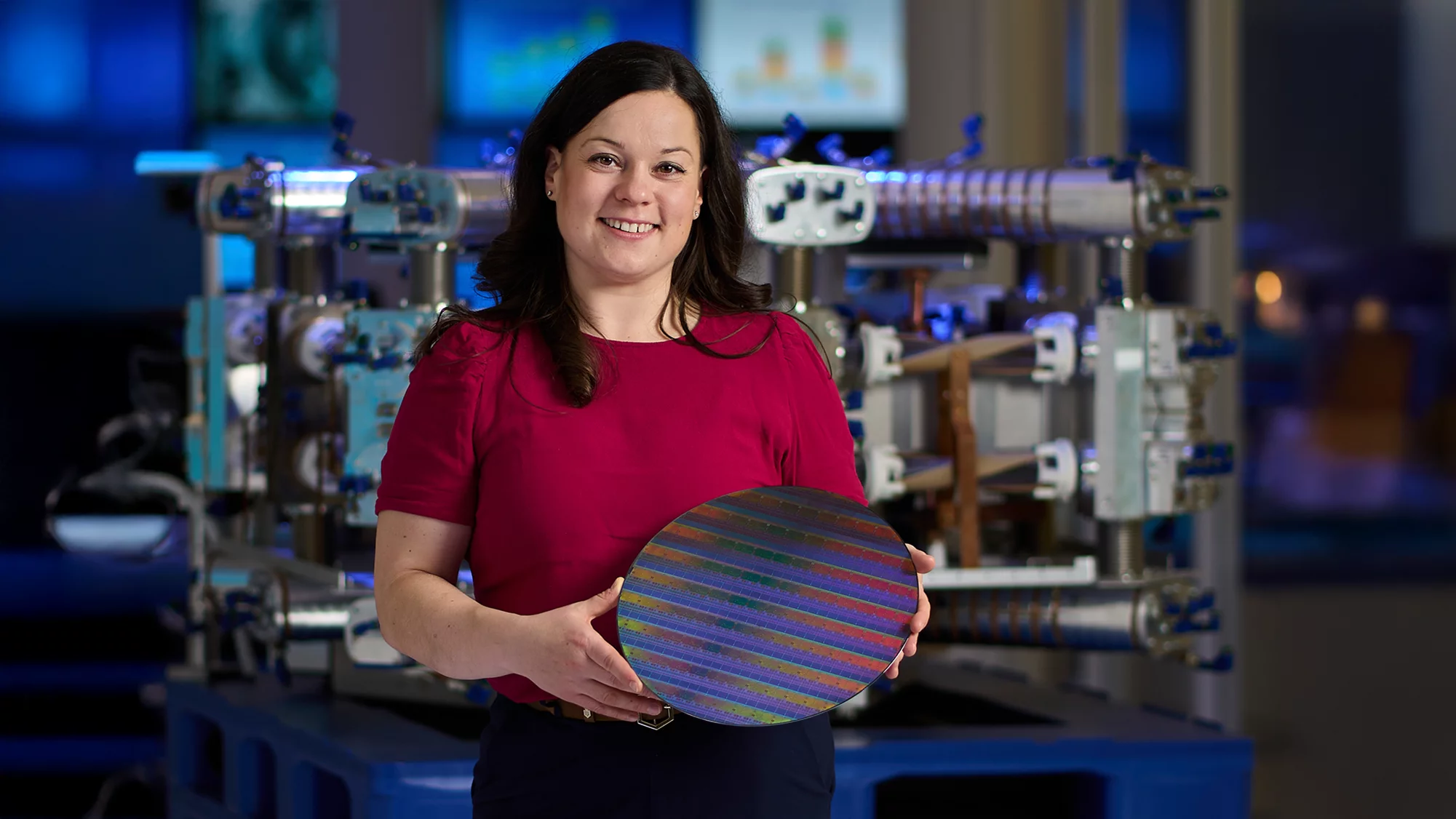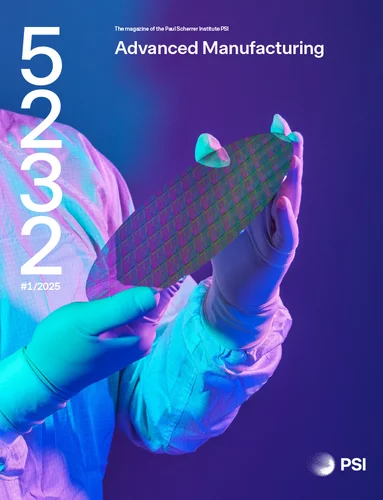Former PSI doctoral candidate Stephanie Smit now works as a patent attorney for a company that is among the most important in the world. That’s because this company builds machines that are worth a fortune and are highly sought after.
Not every important company is also known to the general public. In the current ranking of the most valuable companies in the world, Apple and Microsoft are at the top with a market value of more than three trillion US dollars each. But the business of these two renowned high-tech companies depends, for better or worse, on a company that has its headquarters in the tranquil town of Veldhoven in the Netherlands, where former PSI doctoral candidate Stephanie Smit has been working for five years now. It may not be one of the most expensive companies in the world, but with a market value of around a quarter of a trillion US dollars, it is still one of the top five in Europe. Amazingly, it is still completely unknown to most people.
ASML? “When I applied for the job here, I had honestly never heard of it before,” says Smit. Founded in 1984 as a joint venture between Philips and ASM International, ASML has grown enormously in recent years: since 2019, sales have doubled to almost 28 billion US dollars per year, and profits have more than tripled to nearly eight billion US dollars. ASML has more than 43,000 employees worldwide, 23,000 of whom work at the headquarters alone.
The reason why hardly anyone knows the company, despite its size and success, is that it does not manufacture products for consumers. Its customers are large microchip manufacturers including Intel, Samsung and TSMC, which in turn supply tech companies such as Microsoft and Apple. ASML makes machines that can be used to ‘print’ essential components for microchips – in a process known as lithography. And microchips are in greater demand than ever, because they are found in computers, mobile phones, tablets and almost every kind of smart electronic device. They are the basic building blocks of the modern digital world.
In this industry, ASML is not just anyone. It is the world market leader for lithography machines. “ASML is the company the world depends on” was a headline in the Austrian newspaper Der Standard in 2023. As a patent attorney working for this company, Stephanie Smit makes sure that new ideas and technologies are legally protected. But how does a former PSI researcher who worked on nanofabrication end up becoming an attorney?
A patent attorney is not necessarily a lawyer
“It is a common misconception that patent attorneys are lawyers,” Smit explains. Of course, you have to know your way around patent law. But a scientific background is just as important: patent attorneys must understand the research and technology behind products so that they can translate the innovation, so to speak, into the legal language of a patent. “And for this, my studies in physics, and above ll my work at PSI, were the best possible preparation,” says Smit.
Smit, who grew up on the Shetland Islands, studied in the Scottish city of Aberdeen. “It was probably my father who instilled in me a passion for physics and technology from an early age,” she says. He was a keen amateur pilot and passed on his fascination with aeronautics to his daughter. “I also got my pilot’s licence, but then I decided on something more downto-earth and studied physics.”
At the same time, Smit developed an interest in languages and cultures. After her preliminary diploma, she went to Krakow for a year to immerse herself in Polish culture. In addition to English and some Polish, she now speaks French, German, and Dutch. This international articulacy, combined with her open, communicative nature, is a great advantage in her job as a European patent attorney. After all, she has to interact with specialists from different countries in order to secure patents.
Her time in Krakow inspired her to do an internship abroad after finishing her studies. “I applied to IAESTE, an organisation that arranges technical and scientific internships abroad, also in Japan and Canada, but PSI in Switzerland was my first choice. Because that’s where the cutting-edge research is done. “Especially in view of the opportunity she was given to work hands-on on a complex topic: in ptychographic imaging, in which a sample is scanned with a particle beam for microscopic examination, Smit had to independently set up a special laser configuration. “I knew little about this from my studies, but my colleagues gave me a lot of support.”
She found it exciting to help develop a completely new research approach. Outside the workplace, too, she enjoyed her time in Switzerland and did a lot with other interns and students. Last but not least, it was here that she met her husband, a native of the Netherlands who was also an intern at PSI at the time.
It isn’t that far from high-tech research to high-tech industry.
PhD at the Swiss Light Source
Having both completed their master’s degrees in Aberdeen, they returned to PSI for their doctoral research. Now working in the Laboratory for Microand Nanotechnology, Smit studied the magnetic structures of samples using the Swiss Light Source LS. “I’m very happy about everything I learned at PSI, which now helps me in my job. But above all, I met many wonderful and brilliant people with whom I am still in touch today.”
It was one of those colleagues who gave her the idea of becoming a patent attorney: “She said that, knowing me as she did, it would suit me. I had to look into it first. And it’s true: this job is a perfect match for my interests.” After completing her PhD, Smit did a postgraduate course in patent law at Queen Mary University in London and worked for a patent law firm. “However, I missed the international research atmosphere and the connection with technology. By that time, my husband and I had had two of our three children, and decided we would prefer to raise them in the Netherlands.”
When she heard that ASML was looking for a patent attorney, she saw this as her opportunity. “And we actually felt right away during the interview that it was a good fit – not least because of my background at PSI. It isn’t that far from high-tech research to high-tech industry.”
Smit has this to say about her employer’s machines: “The latest lithography systems are probably among the most complex machines that mankind has ever come up with.” They are as big as a house and chock-full of laser technology and optical components.
Roughly speaking, lithography works by shining highly concentrated light through a stencil onto a millimetre-thin silicon plate called a wafer. A layer of photoresist is fixed in tiny structures while the unexposed remainder of the layer is precisely washed away – or vice versa. The process is repeated several imes, leaving behind an apparently mirror-smooth wafer with densely packed, microscopically small transistors – the switching elements with which the microchips carry out their calculations.
A question of wavelength
Lithography machines use ultraviolet light because its short wavelength enables more precise imprinting than visible light. The density of the transistors determines the performance of the microchip. ASML started with 2,200 transistors per square millimetre. Today, 45 million fit into the same tiny area.
Modern machines work with light in the deep ultraviolet (DUV) range, usually with a wavelength of 193 nanometres. ASML has a global market share of around 85 percent for such machines. But ASML recently became the only supplier in the world to offer EUV systems as well. EUV stands for extreme ultraviolet and works at a wavelength of just 13.5 nanometres – making it possible to build even more powerful chips.
ASML delivered the first EUV machine to Intel in early 2024. According to the Reuters news agency, the cost was around 350 million US dollars. The DUV variants are not much less expensive, though. So it’s no wonder that ASML only needs to sell a few hundred of these systems a year and can still make good money from them. Nor is it any wonder that the average person rarely comes into contact with such machines, and that ASML is therefore not as famous as Microsoft or Apple.
And it is hardly surprising that Stephanie Smit finds it exciting to negotiate the patents of such a manufacturer – ASML holds more than 21,000 patents in total, covering all kinds of parts and mechanisms in the machines. “I’ve been here for five years now, and I’m still amazed to be working for a company on which so much depends,” says Smit. “But I particularly like my colleagues here. They are just as great as the ones I met at PSI.”


